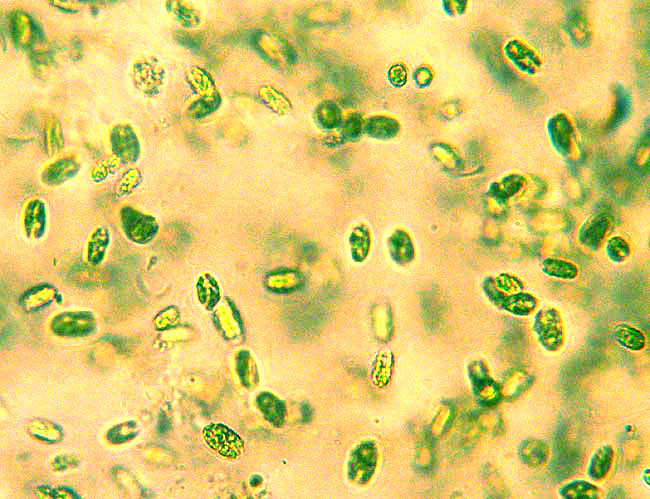Excerpts from Jim Conrad's
Naturalist Newsletter

from the February 9, 2014 Newsletter issued from the Frio Canyon Nature Education Center in the valley of the Dry Frio River in northern Uvalde County, southwestern Texas, on the southern border of the Edwards Plateau; elevation ~1750m (~5750 ft); N29.62°, W99.86°; USA
CHLAMYDOMONAS ALGA
In the diffuse blob of greenness about the size of a mouse's eye floating at the water's surface in the fishbowl of Dry Frio River water on the windowsill, what where the tiny algae among whom the much larger Green Paramecium grazed? The algae are shown above.
The paramecium was about 0.13mm long, but those algae cells are only about 0.01mm in length, a size taxing the magnification capacity of our light microscope. Still, certain identification features are apparent. The algae are unicellular instead of consisting of various cells organized into a filament or a blob. They are slightly egg-shaped, or elongate, instead of spherical. Some display a single, slightly red spot, or "eye." Also, something not shown in the picture is that they were all in constant motion, not traveling in straight lines, but rather just milling about. This movement suggests that they must have had a means of propulsion, like the paramecium's cilia, or else hairlike "flagella," though I couldn't see any.
Thousands of alga species must fit this description, though the barely visible "red eye" is something special. Still, when I browse images of unicellular freshwater algae, one species turns up looking like ours, and that's CHLAMYDOMONAS REINHARDTII. Moreover, that species has a light-sensitive, red eye-spot, and is very common worldwide, in both freshwater and soil, even melting snow. Among its freshwater environments are temporary pools and low-oxygen (eutrophic) ponds and lakes. In other words, this is a species to be expected in a fishbowl of water from a stream.
On the Internet many pictures of Chlamydomonas reinhardtii taken through light microscopes also fail to show appendages the species might use for swimming. However, under certain light conditions or with an electron microscope two hairlike flagella, which propel the cell forward when wiggled, do show up.
Chlamydomonas chloroplasts are cup-shaped and inside each cell there is a starch-synthesizing organelle called a pyrenoid. These features might explain the irregular zones of greenness and transparencies displayed by some of the cells.
Chlamydomonas reinhardtii is much used in labs as a study organism because it's so easy to grow, reproduces both sexually and asexually, can live on nothing but a soup of inorganic salts and light, or else in total darkness in a simple carbon medium such as acetate.
Really, Chlamydomonas reinhardtii is an amazing species, so effectively living under so many growing conditions throughout so much of the world. It seems to have reached a kind of perfection as an organism few other species have.